A “Colossal Archive” Of…Materials

“It’s everything I’ve ever done,” says Lunch over a glass of white wine in Berlin’s Michelberger Hotel. “I’ve been taking photos since 1990, each one needs to be scanned. I have letters from guys I don’t know — letters with bodily fluids. Thirty-seven years is a lot of time for creating. I want it all available.”
The above quote is from a Guardian profile of Lydia Lunch, a…complicated figure from the No Wave scene. She has, as the article points out, a “colossal” archive of materials that demand a good, safe home, for future research and historical purposes.
I’ve been thinking a lot about archives lately, particularly digital ones. Yesterday the New York Times announced that the Fales Library at NYU has acquired an entirely digital archive of the journal Triple Canopy. Marvin J. Taylor, the director of the Fales Library, said:
“The partnership… urges both organizations to rethink what archiving looks like in the digital world. We know how to handle born-digital business files. Working together, we will be creating new ways of preserving born-digital artistic production.”
I mean, there’s a bit of an intellectual leap between bodily fluids and online-only art journals, and I doubt Lydia Lunch is really donating physical fluids under any title, but: how are future generations going to experience the archives of less-than-conventional materials?
For myself, I have no archivable fluids, but I do have probably hundreds of thousands of texts, sexts, emails, and other horribly embarrassing online-only communications. Recently, inspired by all this talk of people having their personal archives sanctioned in public institutions, I told several friends and loved ones to under no circumstances let ANYONE read my emails or whatever after I’m gone. “Please just burn it all,” I said dramatically, “I would die if anyone read it.”
“Haley,” they sighed, exasperated, “you’ll already be dead.”